All About Uscs | Which Test Gives a Better Estimation of the Friction Angle | Introduction of USCS ( Unified Soil Classification System )
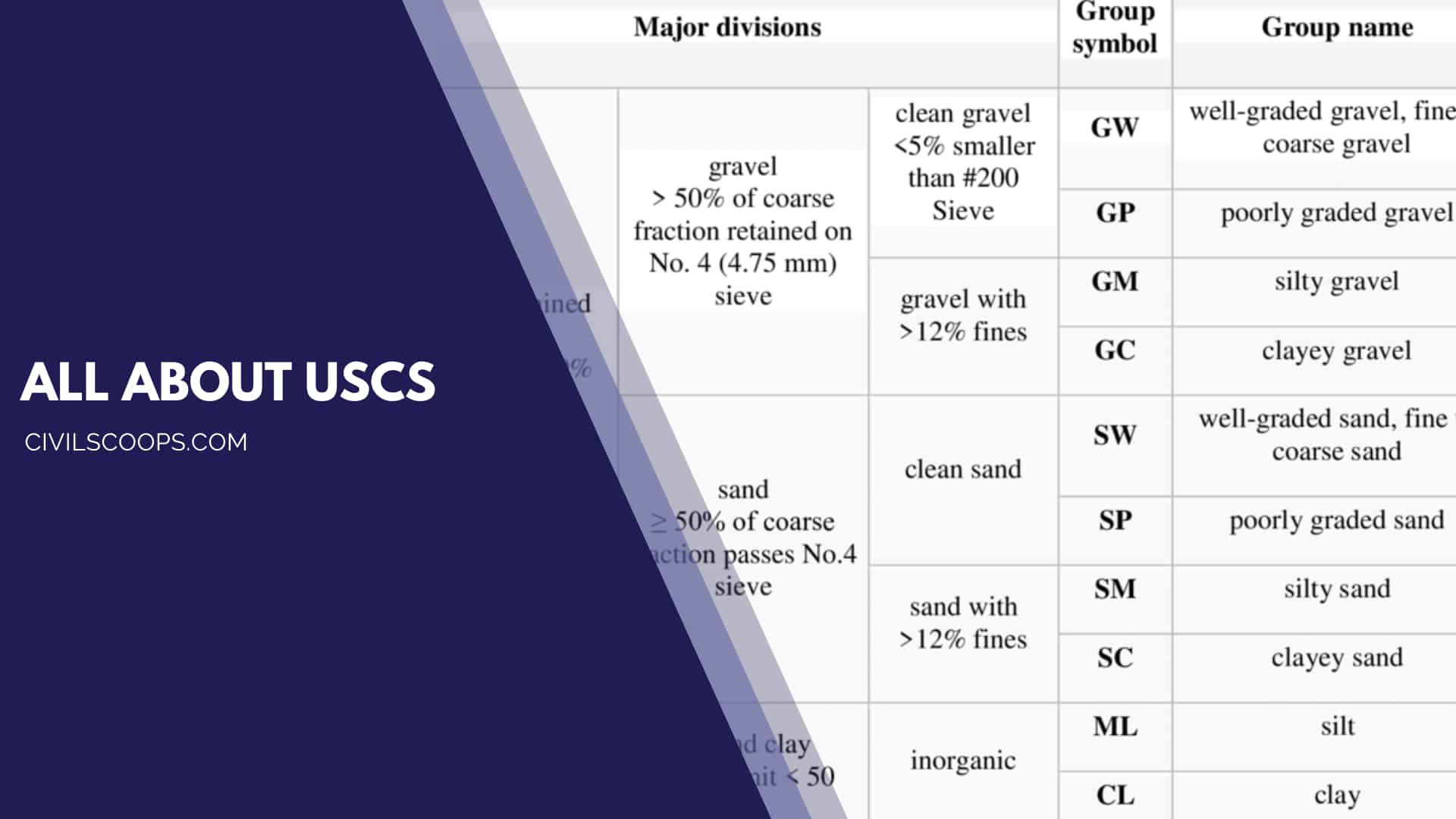
Table of Contents
Which Test Gives a Better Estimation of the Friction Angle?
Usually, the economics of the project dictates the type of test you would use for the determination of the friction angle. Nonetheless, the best test to determine the friction angle of soil is the one that is more analogous to the problem at hand.
For example, if you are to determine the bearing capacity of a square footing, the triaxial test is the best one.
Introduction of USCS ( Unified Soil Classification System )
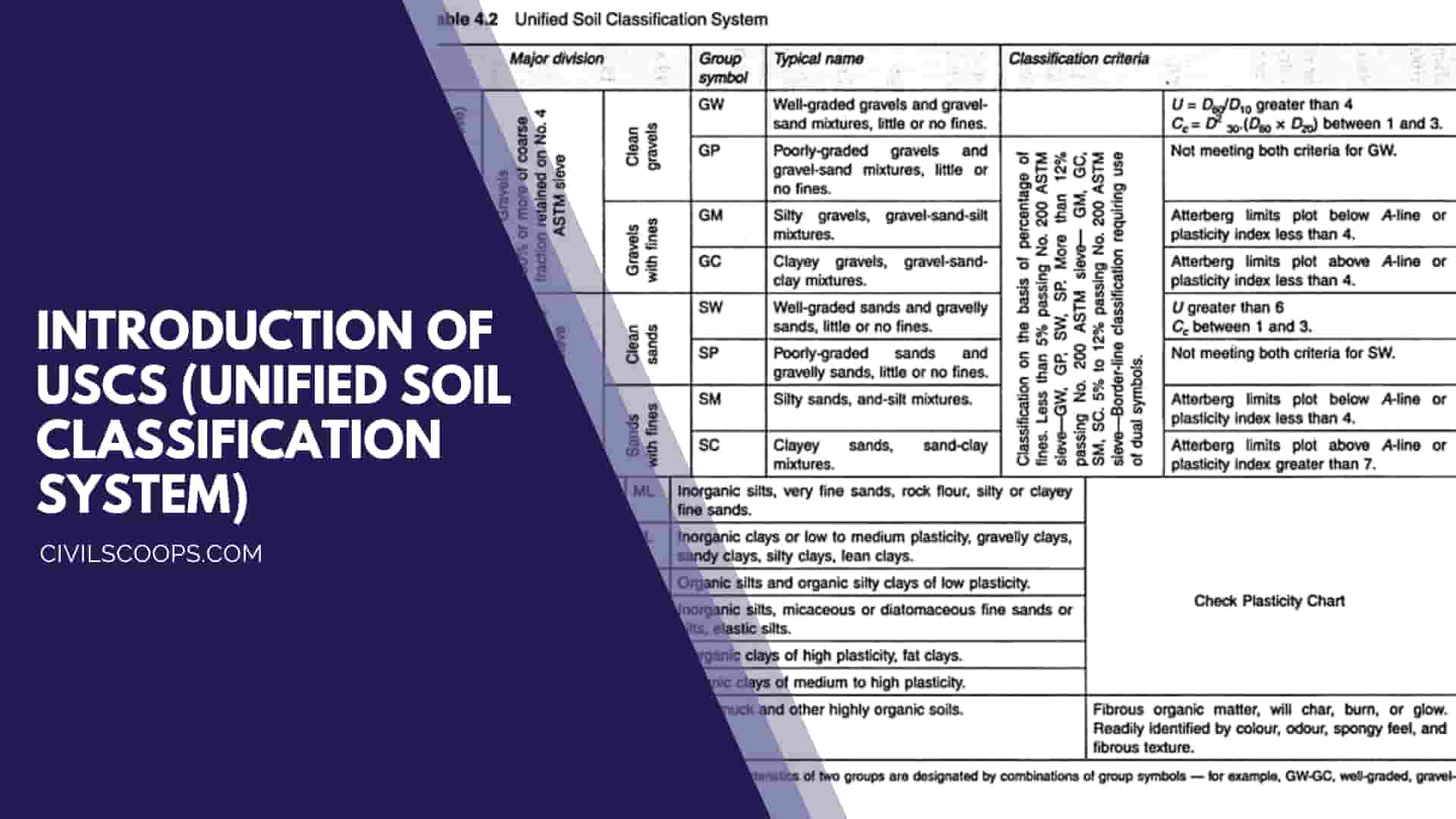
The original form of this system was proposed by Casagrande in 1942 for use in the airfield construction works undertaken by the Army Corps of Engineers during World War II.
In cooperation with the U.S. Bureau of Reclamation, this system was revised in 1952. At present, it is used widely by engineers (ASTM Test Designation D-2487). The Unified classification system is presented in Table 2.
[su_table responsive=”yes” alternate=”no”]
| Unit | Symbols | Description |
|
Primary
|
G | Gravel |
| S | Sand | |
| M | Silt | |
| C | Clay | |
| O | Organic | |
| Pt | Peat | |
|
Secondary
|
W | Well-Graded |
| P | Poorly Graded | |
| M | Non-Plastic Fines | |
| C | Plastic Fines | |
| L | Low Plasticity | |
| H | High Plasticity |
[/su_table]
Table 1 – Symbols Used in USCS
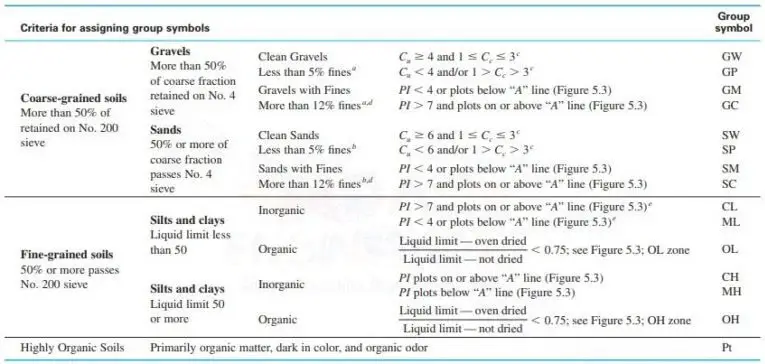
a Gravels with 5 to 12% fine require dual symbols: GW-GM, GW-GC, GP-GM, GP-GC.
b Sands with 5 to 12% fines require dual symbols: SW-SM, SW-SC, SP-SM, SP-SC.
c Cu = D60 / D10 ; Cc = ( D 30 )2 / ( D60 x D10 )
d If 4 ≤ PI ≤ 7 and plots in the hatched area in the below fig (Plasticity chart), use dual symbol GC-GM or SC-SM.
e If 4 ≤ PI ≤ 7 and plots in the hatched area in the below fig (Plasticity chart), use dual symbol CL-ML.
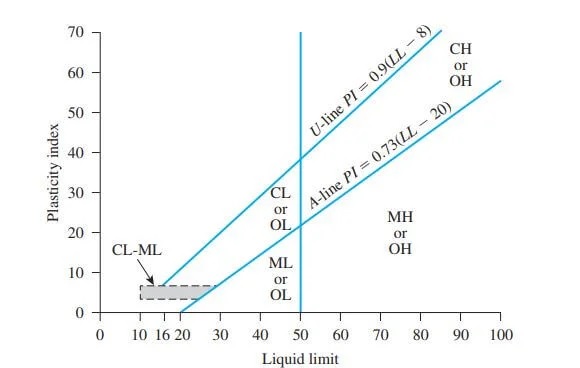
Plasticity chart
For proper classification according to this system, some or all of the following information must be known:
1. Percent of gravel — That is, the fraction passing the 76.2-mm sieve and retained on the No. 4 sieve (4.75-mm opening)
2. Percent of sand — That is, the fraction passing the No. 4 sieve (4.75-mm opening) and retained on the No. 200 sieve (0.075-mm opening)
3. Percent of silt and clay — That is, the fraction finer than the No. 200 sieve (0.075-mm opening)
4. Uniformity coefficient (Cu) and the coefficient of gradation (Cc)
5. Liquid limit and plasticity index of the portion of soil passing the No. 40 sieve
The group symbols for coarse-grained gravelly soils are GW, GP, GM, GC, GC-GM, GW-GM, GW-GC, GP-GM, and GP-GC.
Similarly, the group symbols for fine-grained soils are CL, ML, OL, CH, MH, OH, CL-ML, and Pt.
- Fine Fraction = Percent Passing No. 200 Sieve
- Coarse Fraction = Percent Retained on No. 200 Sieve
- Gravel Fraction = Percent Retained on No. 4 Sieve
- Sand Fraction = (Percent Retained on No. 200 Sieve) – (Percent Retained on No. 4 Sieve)
Also Read: 10 Different Types of Loads on Structures | What Are Structural Loads
USCS Classifies Soils into Two Broad Categories
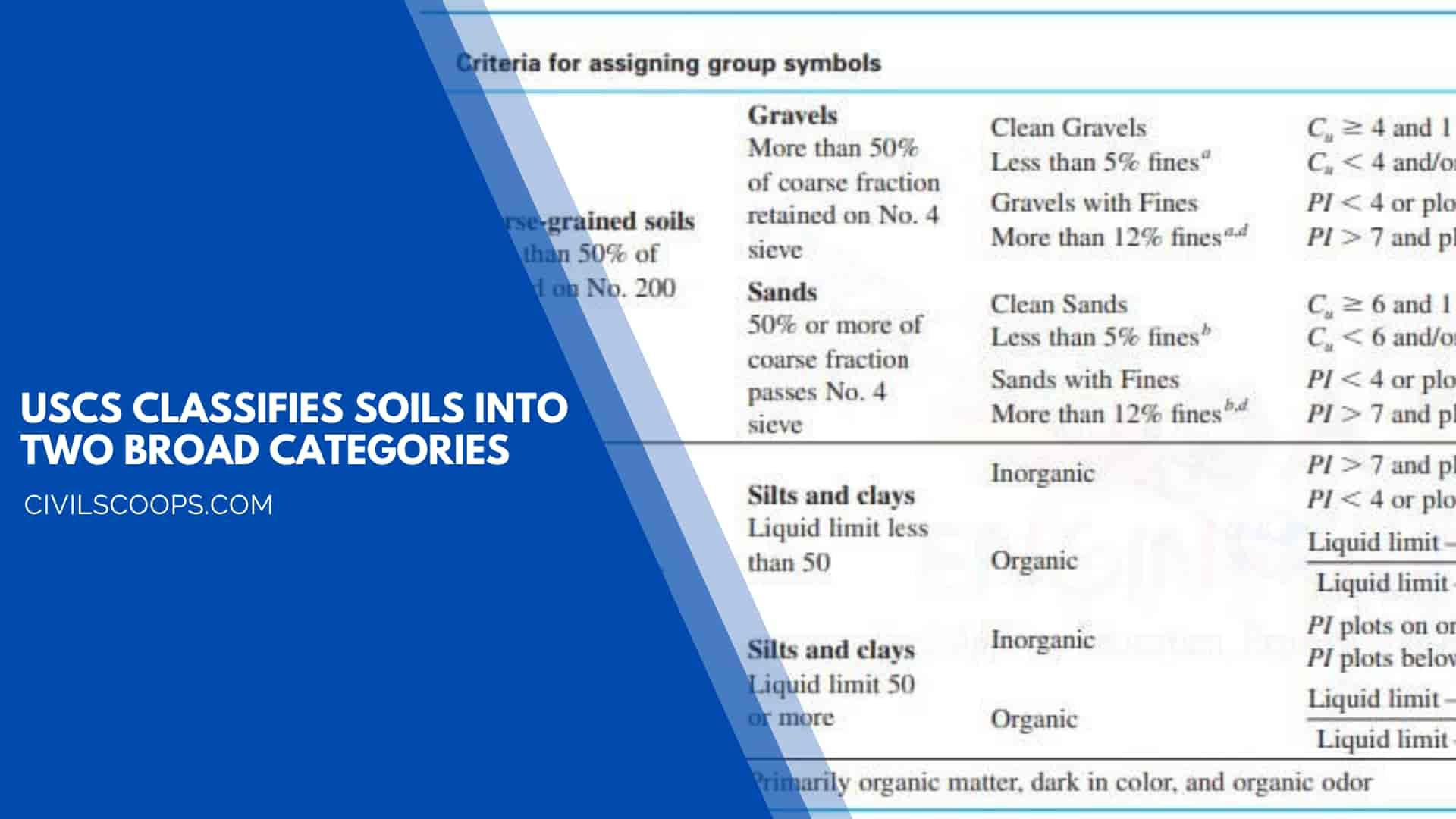
Coarse-Grained Soils—If more than 50% of the soil is retained on the No. 200 (0.075 mm) sieve, it is designated as coarse-grained soil. There are 8 groups of coarse-grained soils.
Fine-Grained Soils—If more than 50% of the soil passes the No. 200 sieve, it is called fine-grained soil. There are 6 groups of fine-grained soils.
Coarse-Grained Soils

The coarse-grained soils are designated as gravel (G) if 50% or more of a coarse fraction (plus 0.075 mm) is retained on the No. 4 (4.75 mm) sieve; otherwise, it is termed sand (S).
If the coarse-grained soils contain less than 5% fines and are well-graded (W), they are given the symbols GW and SW, and if poorly graded (P), the symbols GP and SP.
The criteria for well-grading are given in the above table 1. If the coarse-grained soils contain more than 12% fines, these are designated as GM, GC, SM, or SC, as per the criteria given.
If the percentage of fines is between 5 to 12% dual symbols such as GW-GM, and SP-SM, are used.
Also Read: What Is Composite Masonry | 6 Different Types of Composite Masonry
Fine-Grained Soils
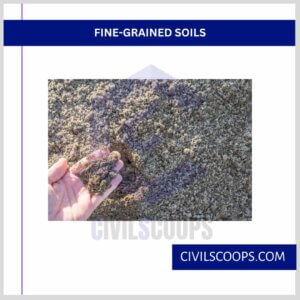
Fine-grained soils are further divided into two types :
1. Soils of low compressibility (L) if the liquid limit is 50% or less. These are given the symbols ML, CL, and OL.
2. Soils of high compressibility (H) if the liquid limit is more than 50%. These are given the symbols MH, CH, and OH.
The exact type of soil is determined from the plasticity chart (above Fig). The A-line has the equation Ip = 0.73 (wt– 20).
It separates the clays from silts. When the plasticity index and the liquid limit plot are in the hatched portion of the plasticity chart, the soil is given the double symbol CL- ML.
The inorganic soil ML and MH and the organic soils OL, and OH plot in the same zones of the plasticity chart. The distinction between inorganic and organic soils is made by oven-drying.
If oven drying decreases the liquid limit by 30% or more, the soil is classified as organic (OL or OH); otherwise, inorganic (ML or MH)
Highly Organic Soils
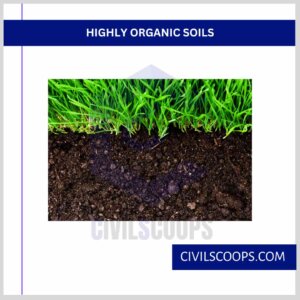
Highly organic soils are identified by visual inspection. These soils are termed peat (Pt).
[su_box title=”FAQ” style=”default” box_color=”#333333″ title_color=”#FFFFFF” radius=”3″ class=”” id=””]
Uscs Unit
For measuring length, the U.S. customary system uses the inch, foot, yard, and mile, which are the only four customary length measurements in everyday use. From 1893, the foot was legally defined as exactly 1200/3937 m (≈0.3048006 m).
What Does Uscs Stand For?
United States Code Service (USCS)
What Are the 4 Classifications of Soil?
OSHA classifies soils into four categories: Solid Rock, Type A, Type B, and Type C. Solid Rock is the most stable, and Type C soil is the least stable. Soils are typed not only by how cohesive they are but also by the conditions in which they are found.
What Are the 3 Classifications of Soil?
Soil can be classified into three primary types based on its texture – sand, silt, and clay. However, the percentage of these can vary, resulting in more compound types of soil such as loamy sand, sandy clay, silty clay, etc. 2.
Cohesion and Friction Angle of Soil
The angle of internal friction (ϕ) and cohesion are the two important physical properties of the soil that determine the angle of rupture, shearing strength, safety factor as well as stability condition of the slope materials.
Friction Angle Formula
The angle, defined by the exact failure plane and the horizontal line was measured for each specimen. Continuously, the friction angle f was calculated by using the equation f = 45 + f /2 and compared with the one which was drawn from Mohr circles.
Effective Angle of Friction
The effective friction angle is interpreted based on three different criteria, i.e., qmax, maximum obliquity, and 15% strain. As evident, the three values of effective friction angle are close to each other, with ϕ’ = 30°at qmax, ϕ’ = 31° at maximum obliquity, and ϕ’ = 29.3° at large strains.
Unified Soil Classification System (Uscs) Was Developed by
In 1948, Arthur Casagrande, commissioned by the Federal Aviation Administration (FAA), developed the Airfield Classification System which eventually became the Unified Soil Classification System (USCS).
Gm Soil Classification
Classify the soil as a CLAYEY GRAVEL (GC) or a CLAYEY SAND (SC) if the fines are clayey as determined by the procedures for fine-grained soil identification. Identify the soil as a SILTY GRAVEL (GM) or a SILTY SAND (SM) if the fines are silty as determined by the pro- cedures for fine-grained soil identification.
[/su_box]
[su_note note_color=”#F2F2F2 ” text_color=”#333333″ radius=”3″ class=”” id=””]
Like this post? Share it with your friends!
Suggested Read –
- How to Calculate Steel in RCC Slab
- What Is Vacuum Concrete | Application of Vacuum Concrete | Advantages & Disadvantages of Vacuum Concrete
- Difference Between Coarse-Grained Soil and Fine-Grained Soil | What Is Coarse-Grained Soil | What Is Fine-Grained Soil
- What Is Earthen Dam | Types of Earthen Dam | Failure of Earthen Dam | Application of Earthen Dam | Advantage & Disadvantage of Earthen Dam
- What Is Inverted Arch Footing | Where Are Uses Inverted Arch Footing | Advantages of Inverted Arch Footing | Disadvantages of Inverted Arch Footing
[/su_note]
Originally posted 2022-11-04 11:23:00.
